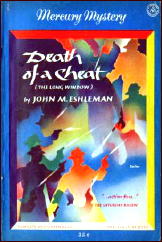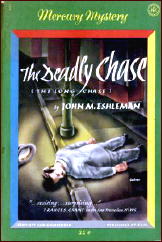Wed 12 Sep 2012
William F. Deeck
JOHN M. ESHLEMAN – The Long Window. Ives Washburn, hardcover, 1953. Mercury Mystery #206, digest paperback, n.d. [1955], as Death of a Cheat.

When Lucy Storm is found strangled in her bedroom after a party in The Long Window, Police Lieutenant Larry Koharik of an anonymous city next to Berkeley, Calif., directs the investigation. Since the partygoers have alibis, the obvious suspects are the husband, who may have killed her because of jealousy, and the black houseboy, who apparently was angry with her for disrupting his plans to return to school.
Despite the fact that Koharik once dated Lucy and knows at least one of the suspects, he continues as head of the investigation. Don’t policemen ever recuse themselves when there might be a conflict of interest, or is that fit only for judges and potential jurors and some lawyers?
While not a great deal is learned about Koharik of a personal nature — quite often in first-person narration these details aren’t provided — it is revealed that he is thirty-three years old and married to a woman who loves, and thus puts up with, him.
Though the investigation is a bit unorthodox, with Koharik socializing with the people who partied at Lucy Storm’s house, it is a good one. Oh, there’s at least one hole in the explanation, the murderer oddly is quite bloodthirsty and then reluctant to kill, and a suspect hides where he and Koharik had been just a few days before.
But none of that is noticed in the reading, for the author carries all before him with splendid prose, solid suspects, and an attractive protagonist. In addition, not that anything extra was needed, there’s a great bit about lie detectors when all the suspects — but you should read it for yourselves.

In The Long Chase, Koharik and his wife are at a society party, meet the rich and noble Senor Diego Castillo, furnish him with a ride, and watch him be shot for the third and fatal time. Then Koharik discovers that Castillo was neither rich nor noble and had a fair number of enemies.
Let me step aside here for a moment and quote a master reviewer, Anthony Boucher, from his introduction to this novel:
Boucher goes on to hope that there would be more cases for Lieutenant Koharik. Unfortunately, there were no others. Thus we will be vouchsafed no additional observations from Koharik such as the following:
For reasons only a publisher would understand — I sure don’t — Mercury Publications chose to publish Eshleman’s second novel featuring Lieutenant Koharik before it published the first one.
September 12th, 2012 at 4:18 pm
I’ve had these two books, the digest paperbacks, since what seems like almost forever, but looking back, it’s probably been only 40 years.
In all that time, I don’t I ever had the urge to read either one, only to find out now that the second was praised by none other than Anthony Boucher — and compared to none other than Dashiell Hammett??
Whether he’s right or wrong — and I’m certainly not challenging him — I never had an inkling.
September 12th, 2012 at 10:56 pm
John M. Eshleman (Jr.) died in 1999. I’ve found his obituary online at http://www.sfgate.com/news/article/John-M-Eshleman-2897576.php. He was a newspaper reporter by trade, but his career suffered a major derailment in 1957 for his alleged pro-Communist beliefs.